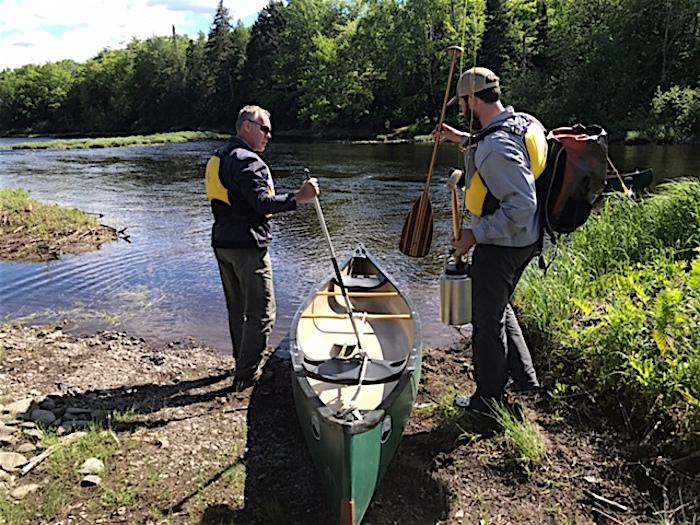
Interior Secretary Ryan Zinke (left), who spent a day last month exploring Katahdin Woods and Waters National Monument in Maine, said he would factor in more than 1 million comments received in his recommendation to President Trump on whether 27 national monuments should be revised in size, abolished, or left alone/DOI
Interior Secretary Ryan Zinke said Tuesday that the more than 1 million comments received on the fate of 27 national monuments will play a role in his recommendations to President Trump on whether the monuments should be revised in size, abolished, or left as is.
President Trump back in April called for the review, saying he wanted to "end another egregious abuse of federal power, and to give that power back to the states and to the people where it belongs. The previous administration used a 100-year-old law known as the Antiquities Act to unilaterally put millions of acres of land and water under strict federal control. Eliminating the ability of the people who actually live in those states to decide how best to use that land."
Since the president issued an executive order directing Secretary Zinke to review 27 national monuments designated by Presidents Clinton, George W. Bush, and Obama, the secretary has been visiting some of the monuments, most notably Bears Ears and the Grand Staircase-Escalante in Utah and Katahdin Woods and Waters in Maine.
On Monday the formal public comment period closed for the review of national monuments. More than 1.2 million comments were received on Regulations.gov, and thousands more were received via postal mail, according to an Interior release.
“Too often under previous administrations, decisions were made in the Washington, D.C., bubble, far removed from the local residents who actually work the land and have to live with the consequences of D.C.’s actions. This monument review is the exact opposite,” said Secretary Ryan Zinke in that release. “President Trump and I opened the formal public comment period – the first-ever for monuments designated under the Antiquities Act – in order to give local stakeholders a voice in the decision-making process. After hearing some feedback, I'd like to remind and reassure folks that even if a monument is modified, the land will remain under federal ownership. I am strictly opposed to the sale or transfer of our public lands, and nothing in this review changes that policy.
“These comments, in addition to the extensive on-the-ground tours of monuments and meetings with stakeholders, will help inform my recommendations on the monuments,” the secretary said. “I appreciate everyone who took the time to log-on or write in and participate in our government.”
According to a statistical analysis by the Center for Western Priorities of more than 650,000 comments received on the matter, 98 percent were in favor of leaving as is, or expanding, the monuments under review.
While Secretary Zinke described past monument decisions as being made "in a bubble," former Interior Secretary Sally Jewell in 2016 traveled to Utah to consider the Bears Ears proposal and spent days in the field and in meetings with opponents and proponents alike. Utah Gov. Gary Herbert's staff even congratulated Secretary Jewell on a public meeting she held with local communities.
As required by the executive order, Secretary Zinke submitted an interim report to the White House in June with various recommendations and observations on Bears Ears National Monument, which suggested the monument be reduced in size to conform with the intent of the Antiquities Act, that of designating the smallest compatible area. The report also recommended the creation of a national conservation area, and official co-management by the local Tribal governments.
The report came after the secretary spent several days on the ground in Utah touring the monument by air, car, foot, and horseback, speaking with stakeholders from tribal, local, state and federal government, as well as representatives from the conservation, historic preservation, agriculture, tourism, and education sectors.
Secretary Zinke also traveled to Maine’s Katahdin Woods and Waters National Monument, and to Boston to hold meetings on the Northeast Canyons and Seamounts National Marine Monument off the coast of New England. The Secretary plans to visit Oregon, New Mexico, and Nevada in the coming weeks.
Regarding the comment period, the executive order stated:
In making the requisite determinations, the Secretary is directed to consider:
(i) the requirements and original objectives of the Act, including the Act’s requirement that reservations of land not exceed “the smallest area compatible with the proper care and management of the objects to be protected”;
(ii) whether designated lands are appropriately classified under the Act as “historic landmarks, historic and prehistoric structures, [or] other objects of historic or scientific interest”;
(iii) the effects of a designation on the available uses of designated Federal lands, including consideration of the multiple-use policy of section 102(a)(7) of the Federal Land Policy and Management Act (43 U.S.C. 1701(a)(7)), as well as the effects on the available uses of Federal lands beyond the monument boundaries;
(iv) the effects of a designation on the use and enjoyment of non-Federal lands within or beyond monument boundaries;
(v) concerns of State, tribal, and local governments affected by a designation, including the economic development and fiscal condition of affected States, tribes, and localities;
(vi) the availability of Federal resources to properly manage designated areas; and
(vii) such other factors as the Secretary deems appropriate.
82 FR 20429-20430 (May 1, 2017).






Comments
Bulloney.
I'm certain he is talking about whatever comments he got from his boss before he started.